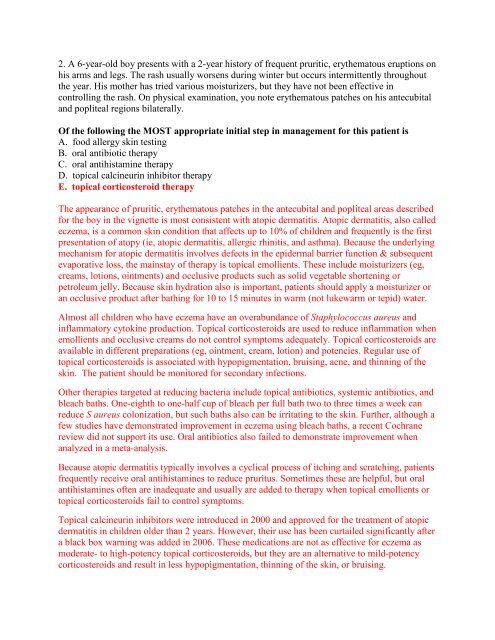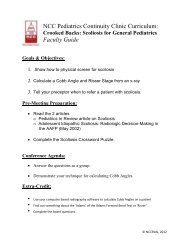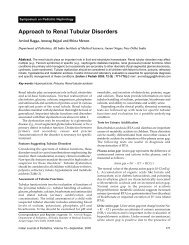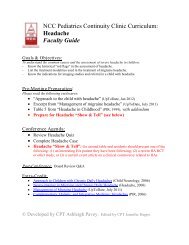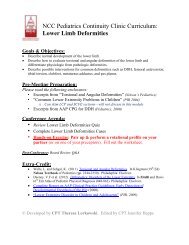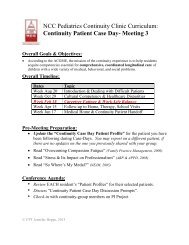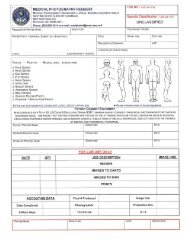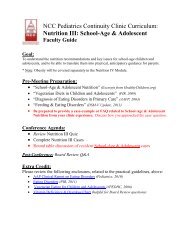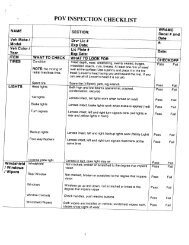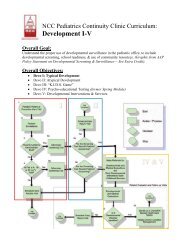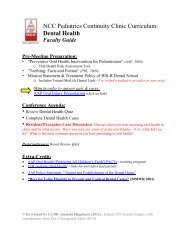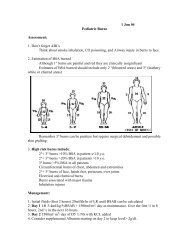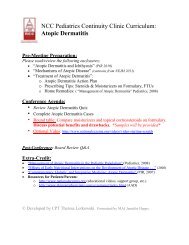NCC Pediatrics Continuity Clinic Curriculum: Atopic Dermatitis ...
NCC Pediatrics Continuity Clinic Curriculum: Atopic Dermatitis ...
NCC Pediatrics Continuity Clinic Curriculum: Atopic Dermatitis ...
Create successful ePaper yourself
Turn your PDF publications into a flip-book with our unique Google optimized e-Paper software.
2. A 6-year-old boy presents with a 2-year history of frequent pruritic, erythematous eruptions on<br />
his arms and legs. The rash usually worsens during winter but occurs intermittently throughout<br />
the year. His mother has tried various moisturizers, but they have not been effective in<br />
controlling the rash. On physical examination, you note erythematous patches on his antecubital<br />
and popliteal regions bilaterally.<br />
Of the following the MOST appropriate initial step in management for this patient is<br />
A. food allergy skin testing<br />
B. oral antibiotic therapy<br />
C. oral antihistamine therapy<br />
D. topical calcineurin inhibitor therapy<br />
E. topical corticosteroid therapy<br />
The appearance of pruritic, erythematous patches in the antecubital and popliteal areas described<br />
for the boy in the vignette is most consistent with atopic dermatitis. <strong>Atopic</strong> dermatitis, also called<br />
eczema, is a common skin condition that affects up to 10% of children and frequently is the first<br />
presentation of atopy (ie, atopic dermatitis, allergic rhinitis, and asthma). Because the underlying<br />
mechanism for atopic dermatitis involves defects in the epidermal barrier function & subsequent<br />
evaporative loss, the mainstay of therapy is topical emollients. These include moisturizers (eg,<br />
creams, lotions, ointments) and occlusive products such as solid vegetable shortening or<br />
petroleum jelly. Because skin hydration also is important, patients should apply a moisturizer or<br />
an occlusive product after bathing for 10 to 15 minutes in warm (not lukewarm or tepid) water.<br />
Almost all children who have eczema have an overabundance of Staphylococcus aureus and<br />
inflammatory cytokine production. Topical corticosteroids are used to reduce inflammation when<br />
emollients and occlusive creams do not control symptoms adequately. Topical corticosteroids are<br />
available in different preparations (eg, ointment, cream, lotion) and potencies. Regular use of<br />
topical corticosteroids is associated with hypopigmentation, bruising, acne, and thinning of the<br />
skin. The patient should be monitored for secondary infections.<br />
Other therapies targeted at reducing bacteria include topical antibiotics, systemic antibiotics, and<br />
bleach baths. One-eighth to one-half cup of bleach per full bath two to three times a week can<br />
reduce S aureus colonization, but such baths also can be irritating to the skin. Further, although a<br />
few studies have demonstrated improvement in eczema using bleach baths, a recent Cochrane<br />
review did not support its use. Oral antibiotics also failed to demonstrate improvement when<br />
analyzed in a meta-analysis.<br />
Because atopic dermatitis typically involves a cyclical process of itching and scratching, patients<br />
frequently receive oral antihistamines to reduce pruritus. Sometimes these are helpful, but oral<br />
antihistamines often are inadequate and usually are added to therapy when topical emollients or<br />
topical corticosteroids fail to control symptoms.<br />
Topical calcineurin inhibitors were introduced in 2000 and approved for the treatment of atopic<br />
dermatitis in children older than 2 years. However, their use has been curtailed significantly after<br />
a black box warning was added in 2006. These medications are not as effective for eczema as<br />
moderate- to high-potency topical corticosteroids, but they are an alternative to mild-potency<br />
corticosteroids and result in less hypopigmentation, thinning of the skin, or bruising.


